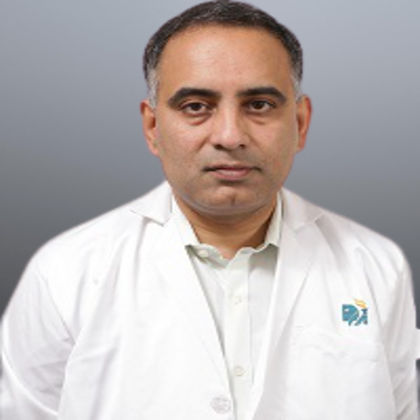Understanding DIBH: A Safer Approach to Breast Cancer Radiation
Learn how the Deep Inspiration Breath Hold (DIBH) technique protects the heart during breast cancer radiation by creating a safe distance between the radiation beam and the heart.

Written by Dr. M L Ezhilarasan
Reviewed by Dr. Rohinipriyanka Pondugula MBBS
Last updated on 4th Oct, 2025

Introduction
When facing a breast cancer diagnosis, particularly in the left breast, radiation therapy is a highly effective treatment to eliminate any remaining cancer cells after surgery. However, its proximity to the heart has long been a concern for both patients and oncologists. This is where the Deep Inspiration Breath Hold (DIBH) technique comes in as a significant advancement in patient care. DIBH is a specialised radiotherapy method designed to protect your heart during treatment. By simply taking and holding a deep breath, you actively help create a safe distance between the radiation beam and your heart, substantially reducing the risk of long-term cardiac side effects. This article will demystify the DIBH technique, explaining how it works, what the procedure feels like, and who can benefit from this heart-sparing approach. We’ll guide you through the science and the patient experience, empowering you with knowledge for discussions with your healthcare team. If you are undergoing radiation treatment planning, understanding options like DIBH is a crucial step in your journey.
What is the DIBH Technique? The Core Concept
At its core, the Deep Inspiration Breath Hold (DIBH) technique is an elegant solution to a complex anatomical problem. It is a form of motion management used in radiation oncology. During a standard radiation treatment for breast cancer, you would breathe normally (free breathing). But with each breath, your chest and the organs within it—including the heart—move slightly. For tumours on the left side, the heart can sometimes lie directly in the path of the radiation beam or very close to it.
The Problem: Protecting the Heart During Left-Sided Breast Cancer Radiation
The primary challenge is minimising the radiation dose to the heart. Even with modern, precise radiation machines, some scatter radiation can reach the heart. Studies have shown that exposure to radiation can increase the long-term risk of developing heart disease, such as coronary artery disease, years after treatment. This risk, while relatively small, is a serious consideration, especially for younger patients with many years ahead of them. The goal, therefore, is to move the heart as far away from the radiation field as possible.
The DIBH Solution: Creating a Safety Margin
The DIBH solution is remarkably patient-powered. When you take a deep breath and hold it, your lungs expand. This expansion pushes the diaphragm downward and, crucially, rotates the heart away from the chest wall and deeper into the chest cavity. This action creates a larger, safer gap between the breast tissue being treated and the heart. Think of it as creating a protective buffer zone. By consistently holding your breath at the same deep level for each treatment, the radiation therapists can target the cancer with high precision while sparing the heart, making the benefits of DIBH for breast cancer substantial and well-documented.
The Science Behind DIBH: How a Deep Breath Protects Your Heart
The effectiveness of DIBH isn't just theoretical; it's grounded in clear anatomical and dosimetric principles. The human body is designed in a way that deep inhalation naturally alters the position of thoracic organs.
Anatomical Changes During Deep Inhalation
When you inhale deeply, the volume of your thoracic cavity increases. This causes the lungs to inflate significantly. The left lung, which sits adjacent to the heart, expands and pushes the heart downward, backward, and away from the left chest wall (the parietal pericardium). This shift can amount to several centimetres—a significant distance in the world of radiation oncology where millimetres matter. This repositioning is the fundamental mechanism that makes the DIBH technique so valuable for heart protection.
Quantifying the Benefit: Data on Heart Dose Reduction
Numerous clinical studies have quantified the benefit. Research published in journals like International Journal of Radiation Oncology, Biology, Physics (IJROBP) consistently shows that DIBH can reduce the radiation dose to the heart by 50% or more compared to free-breathing techniques. For critical structures like the left anterior descending (LAD) coronary artery, the dose reduction can be even greater. A 2013 study from The New England Journal of Medicine directly linked radiation dose to the heart with an increased rate of major coronary events, highlighting why techniques like DIBH are now considered a standard of care for eligible patients. This data provides a powerful, evidence-based reason for adopting this heart-sparing approach.
The DIBH Procedure: What to Expect Step-by-Step
If your radiation oncologist recommends DIBH, knowing what to expect can ease anxiety. The process is collaborative and supported by technology and a caring team.
Step 1: Simulation and Training
Your first encounter with DIBH will be during the CT simulation session. This is where the team plans your treatment. You’ll lie on the treatment couch in the exact position you’ll be in for each session. The therapists will then guide you through the DIBH procedure steps. You’ll be given a device to assist you, most commonly a pair of visual feedback goggles. You’ll practice taking a deep breath and holding it for about 20-30 seconds, which is the typical length of time needed to deliver the radiation beam. The team will find a comfortable, reproducible breath-hold level for you.
Step 2: The Role of Visual Feedback and Coaching
The key to consistent treatment is feedback. You’ll wear goggles that display a simple graph or animation. As you breathe in, a marker on the screen will move. The therapists will set a “gate” or a target zone on the screen that corresponds to your deep breath-hold level. Your job is to breathe in until the marker enters the gate and hold it there. This visual cue, combined with calm coaching from the therapists over an intercom, makes the process very manageable. It turns an internal sensation into an external, visual task.
Consult an Oncologist for the best advice
Step 3: Daily Treatment with DIBH
Each daily treatment will mirror the simulation. After positioning you perfectly, the therapists will go to a control room where they can see and hear you. They will instruct you to begin the breath-hold sequence via the intercom. You’ll take a deep breath, hold it when the marker is in the gate, and the radiation beam will turn on automatically once you are stable. After the beam finishes, you can exhale and relax for a moment before repeating the process for the next beam angle. The entire DIBH treatment is non-invasive and painless.
Who is a Candidate for Deep Inspiration Breath Hold?
Primary Candidates: Left-Sided Breast Cancer Patients
The most common and established candidates for the DIBH technique are patients receiving radiation for cancer in the left breast. This is because the heart is situated predominantly on the left side of the chest. Who qualifies for DIBH is ultimately decided by your radiation oncologist based on your individual anatomy as seen on the planning CT scan. If the heart is too close to the radiation field during free breathing, DIBH will almost certainly be recommended.
Other Potential Applications: Lymphoma and Lung Cancer
While most prominently used for breast cancer, the principle of DIBH is being explored for other cancers in the chest. For instance, in treating mediastinal lymphoma or certain lung tumours, DIBH can help spare healthy lung tissue or other critical structures like the oesophagus, further minimising side effects. The decision to use DIBH in these cases is highly individualised.
DIBH vs. Free Breathing Radiotherapy: A Clear Comparison
Understanding the difference between these two techniques is key. The choice between DIBH vs free breathing radiation hinges on the trade-off between treatment safety and complexity.
Potential Challenges and Considerations of DIBH
While highly beneficial, DIBH is not without its considerations.
Patient-Specific Factors: Lung Capacity and Comfort
The technique requires patients to be able to hold their breath for short periods consistently. Some patients with pre-existing respiratory conditions like severe COPD may find this challenging. However, the breath-hold level is customised to each patient's ability—it’s not about taking the biggest breath possible, but a deep, comfortable, and repeatable one. Communication with your therapy team is vital to ensure comfort. It's natural to wonder, "is DIBH technique painful?" The answer is no; the process itself is not painful, though holding a breath can require a bit of effort.
Technical and Workflow Considerations
From a clinic's perspective, DIBH requires specialised equipment (like visual feedback systems) and adds time to each treatment slot. It also demands highly trained therapists to coach patients effectively. Despite these factors, the long-term benefits of deep inspiration breath hold for patient health make it a worthwhile investment for modern cancer centres.
Conclusion
The Deep Inspiration Breath Hold (DIBH) technique represents a significant stride forward in personalised and safe cancer care. It transforms patients from passive recipients of treatment into active participants in their own safety, leveraging a simple, natural bodily function to achieve a profound protective effect. By understanding how DIBH works—creating a physical buffer to minimise radiation exposure to the heart—you can approach your treatment with greater confidence and peace of mind. The procedure, while requiring focus, is well-supported by technology and a dedicated medical team. The ultimate goal of oncology is not just to treat cancer effectively but to ensure a high quality of life for years after treatment. DIBH is a powerful tool in achieving that goal, significantly reducing the risk of future cardiac complications. If you are preparing for radiation therapy, especially for left-sided breast cancer, having an informed discussion with your doctor about DIBH is a critical step in your care journey. For a comprehensive evaluation and to discuss advanced treatment techniques like DIBH, you can consult with a specialist oncologist online through Apollo24|7.
Consult an Oncologist for the best advice
Consult an Oncologist for the best advice

Dr Sunita Samleti
Oncologist
18 Years • M.D. (Pathology)- TN Medical College, Mumbai University, Mumbai, Mar 2005 M.B.B.S. Grant Medical College, Mumbai University, Mumbai, Oct 1999
Chinagadila
Apollo Hospitals Health City Unit, Chinagadila

Dr. Sanchayan Mandal
Medical Oncologist
17 Years • MBBS, DNB Raditherapy, DrNB Medical Oncology
East Midnapore
VIVEKANANDA SEBA SADAN, East Midnapore

Dr Gowshikk Rajkumar
Oncologist
10 Years • MBBS, DMRT, DNB in Radiation oncology
Bengaluru
Apollo Clinic, JP nagar, Bengaluru

Dr.sanchayan Mandal
Medical Oncologist
17 Years • MBBS, DrNB( MEDICAL ONCOLOGY), DNB (RADIOTHERAPY),ECMO. PDCR. ASCO
Kolkata
Dr. Sanchayan Mandal Oncology Clinic, Kolkata

Dr. Raja T
Oncologist
20 Years • MBBS; MD; DM
Chennai
Apollo Hospitals Greams Road, Chennai
(200+ Patients)
Consult an Oncologist for the best advice

Dr Sunita Samleti
Oncologist
18 Years • M.D. (Pathology)- TN Medical College, Mumbai University, Mumbai, Mar 2005 M.B.B.S. Grant Medical College, Mumbai University, Mumbai, Oct 1999
Chinagadila
Apollo Hospitals Health City Unit, Chinagadila

Dr. Sanchayan Mandal
Medical Oncologist
17 Years • MBBS, DNB Raditherapy, DrNB Medical Oncology
East Midnapore
VIVEKANANDA SEBA SADAN, East Midnapore

Dr Gowshikk Rajkumar
Oncologist
10 Years • MBBS, DMRT, DNB in Radiation oncology
Bengaluru
Apollo Clinic, JP nagar, Bengaluru

Dr.sanchayan Mandal
Medical Oncologist
17 Years • MBBS, DrNB( MEDICAL ONCOLOGY), DNB (RADIOTHERAPY),ECMO. PDCR. ASCO
Kolkata
Dr. Sanchayan Mandal Oncology Clinic, Kolkata

Dr. Raja T
Oncologist
20 Years • MBBS; MD; DM
Chennai
Apollo Hospitals Greams Road, Chennai
(200+ Patients)
More articles from Breast Cancer
Frequently Asked Questions
What if I can't hold my breath for very long?
Don't worry! The therapy team will work with you to find a comfortable and sustainable breath-hold level. It’s not a test of lung capacity. The level is set individually, and the holds are typically only 20-30 seconds, with breaks in between.
Are there any extra side effects with DIBH compared to normal radiation?
There are no additional side effects specifically from the DIBH technique itself. The common side effects of breast radiation (like skin redness or fatigue) are the same. The main difference is the potential benefit of reduced long-term cardiac side effects.
Is DIBH used for right-sided breast cancer?
It is less common because the heart is farther away on the right side. However, in specific cases where the tumour is very central or the patient's anatomy is unusual, a radiation oncologist might still consider it to spare lung tissue.
How much does DIBH reduce the risk of heart problems?
While it's difficult to give a precise percentage for an individual, studies have shown that DIBH reduces the radiation dose to the heart by over 50%. Since the risk of heart disease is directly related to the dose received, this represents a substantial reduction in risk.
Is the DIBH technique available at all cancer centres?
It is becoming a standard of care at most modern, comprehensive cancer centres. However, it does require specific technology and training. It is always appropriate to ask your radiation oncologist if it is available and recommended for you.

.webp)


